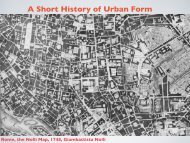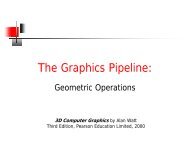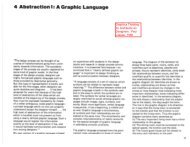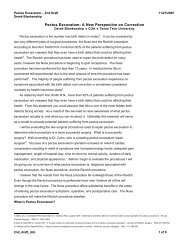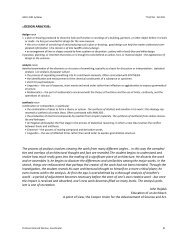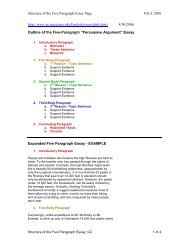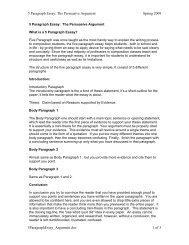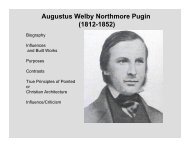Relational aspects of space in design
Relational aspects of space in design
Relational aspects of space in design
You also want an ePaper? Increase the reach of your titles
YUMPU automatically turns print PDFs into web optimized ePapers that Google loves.
.7.6All_people/ft..5.4.3.2.101.5 2 2.5 3 3.5 4 4.5 5 5.5 6RRA3rightw ithoutrdY = -.14 + .087 * X; R^2 = .423Figure 3 Scatergram shows the relationship <strong>of</strong> thepresence <strong>of</strong> people <strong>in</strong> TexasTech campus with theirSyntax values.The configurational structure revealed by computer analysis is basedonly on how each road is connected to others and not on any otherfactor; yet it has closely resembled the exist<strong>in</strong>g situation 1 .The second example is <strong>of</strong> the TexasTech campus. An ongo<strong>in</strong>g study <strong>of</strong>pedestrian behavior and configurational analysis <strong>of</strong> the exist<strong>in</strong>g paths<strong>in</strong>dicate that presence <strong>of</strong> people <strong>in</strong> any path is a function <strong>of</strong> its syntaxvalue 2 i.e. more connected <strong>space</strong>s will have more people <strong>in</strong> them(r=.650, p=.0006, see figure 3 and 4). This is another example <strong>of</strong> theapplied value <strong>of</strong> syntactic studies. Figure 5 shows the work undertakenby graduate students 3 as part <strong>of</strong> Arch 5362, Theory <strong>in</strong> Architecture.Work<strong>in</strong>g with data from a small sample regard<strong>in</strong>g ‘imagability’ <strong>of</strong> thecampus, (Lynch, 1960) the students proposed appropriate paths (shown<strong>in</strong> red) <strong>in</strong> the campus. If this is compared with the master plan <strong>design</strong>edby HOK and partners (Figure 6) we see a remarkable similarity.Additionally, syntactic analysis <strong>of</strong> the master plan confirms that the newpaths will be the most connected areas <strong>in</strong> campus and therefore may beexpected to be most crowded. It is <strong>in</strong>terest<strong>in</strong>g to note that the common<strong>aspects</strong> <strong>of</strong> both research on students ‘image <strong>of</strong> the campus’ and anarchitect’s <strong>in</strong>tuition are be<strong>in</strong>g matched by computational outcomes. Onecan therefore extend these ideas and beg<strong>in</strong> to understand the usefulness<strong>of</strong> Space Syntax as a <strong>design</strong> tool.Figure 4 Space Syntax analysis <strong>of</strong> the pathways <strong>in</strong>TexasTech campus.Figure 5 Student proposal for new pedestrian paths(shown <strong>in</strong> red) <strong>in</strong> TexasTech campus. This is based on astudy <strong>of</strong>’ imagibility’ <strong>of</strong> the campus.Syntax results <strong>in</strong> Lubbock, TX are not isolated. They follow a patternseen <strong>in</strong> numerous research literatures where configuration has beenfound to be <strong>in</strong>dicative <strong>of</strong> various patterns. For example, Alan Penn(2001) <strong>in</strong>forms us that about 60 to 80% <strong>of</strong> variation <strong>in</strong> movement ratesfrom location to location, <strong>in</strong> areas where land uses and developmentdensities are relatively homogenously distributed can be accounted forby measures <strong>of</strong> spatial configuration alone. This is based on plentifulstudies <strong>in</strong> various cultures distributed globally. The author himself hasstudied the role <strong>of</strong> configuration <strong>in</strong> the case <strong>of</strong> wayf<strong>in</strong>d<strong>in</strong>g <strong>in</strong> three largeUS hospitals and has concluded that configurational properties <strong>of</strong> <strong>space</strong>sand their use dur<strong>in</strong>g wayf<strong>in</strong>d<strong>in</strong>g are correlated strongly (average r=.60).Additionally <strong>space</strong>s <strong>of</strong> higher values also feature <strong>in</strong> the cognitive maps(average=.68) and that syntactic properties <strong>of</strong> entry po<strong>in</strong>ts <strong>in</strong>fluencewayf<strong>in</strong>d<strong>in</strong>g success. (Haq, 1999) It has been shown that relationalproperties are also important factors <strong>in</strong> crime distribution and prevention(see Hillier, 1999 for British examples and Fanek, 1997 for studies <strong>in</strong>Aust<strong>in</strong>, TX) and to some degree features <strong>in</strong> the success or failures <strong>of</strong>shopp<strong>in</strong>g areas. (Brown, 1994) Also, Syntax methods have been quiteuseful <strong>in</strong> archeological explorations. (Ferguson, 1996)The most pervasive argument <strong>of</strong> Space Syntax is that configuration<strong>in</strong>fluences location characteristics and this impacts our understand<strong>in</strong>gand use <strong>of</strong> <strong>space</strong>s. It also provides computer programs to modelconfigurational values. Recently, Space Syntax has moved to thepr<strong>of</strong>essional realm where its computational methods are called upon toanalyze exist<strong>in</strong>g conditions and to <strong>in</strong>vestigate <strong>design</strong> proposals. Theyhave proved to be extremely useful <strong>in</strong> <strong>design</strong> decision mak<strong>in</strong>g. SpaceSyntax br<strong>in</strong>gs rigor to the <strong>design</strong> process specifically those <strong>in</strong>volv<strong>in</strong>gcomplex build<strong>in</strong>gs, community development and urban <strong>design</strong>.1 A full fledged analysis <strong>of</strong> Lubbock city is presently be<strong>in</strong>g undertaken by the author at TexasTech University.2 A larger study <strong>of</strong> TexasTech Campus is also <strong>in</strong> progress.3 Alicia Jones, Eden Liv<strong>in</strong>gstone and Just<strong>in</strong> Noble, Fall 2001




